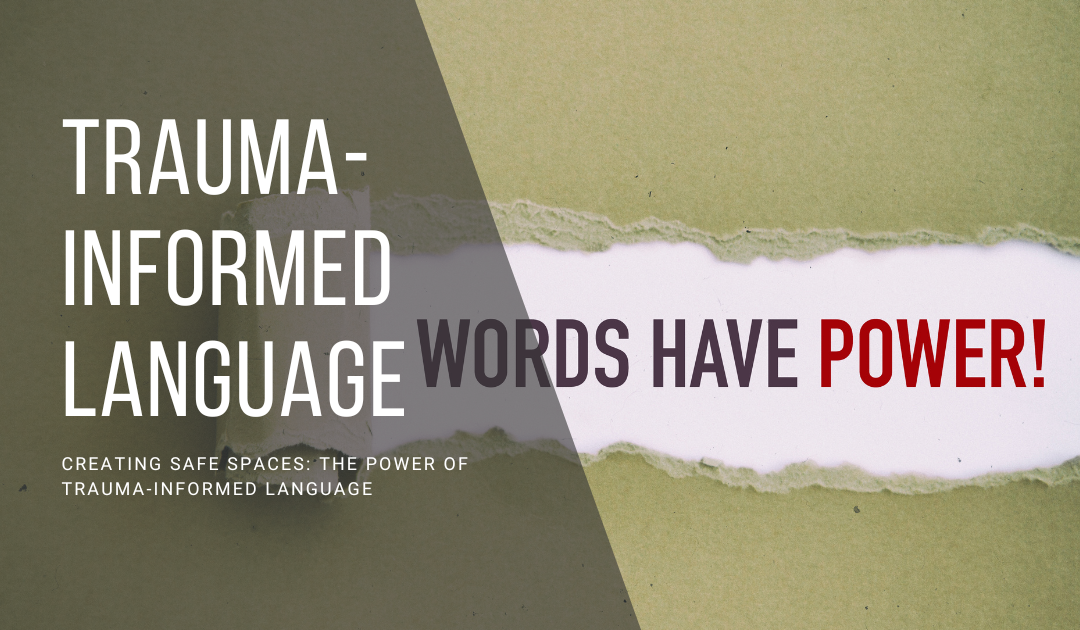In a world where compassion and understanding are paramount, the significance of trauma-informed language cannot be overstated. For individuals who have experienced trauma, the words we use and the way we communicate can have a profound impact on their well-being. In this blog post, we will explore the concept of trauma-informed language and delve into why it is crucial for fostering safe environments for those who have endured traumatic experiences.
Understanding Trauma-Informed Language
Trauma-informed language represents a holistic approach to communication, acknowledging and addressing the potential impact of trauma on individuals. This approach goes beyond the mere selection of words; it extends to encompass tone, body language, and the overall style of communication. By weaving sensitivity, respect, and mindfulness into our language, we create an environment that is conducive to supporting those who may have experienced significant hardships.
In delving deeper into trauma-informed language, we uncover a nuanced communication landscape. Research indicates that 55% of communication is conveyed through nonverbal cues, 38% through vocal elements, and a mere 7% through words alone. This statistical breakdown underscores the importance of understanding the interconnected nature of verbal and nonverbal communication in the context of trauma.
Embracing trauma-informed language entails not only choosing sensitive words but also adopting respectful tones and cultivating mindful body language. This holistic approach becomes a cornerstone in fostering safe spaces for individuals navigating the complexities of trauma. It goes beyond verbal expression to create an atmosphere where individuals feel genuinely heard, supported, and validated in their experiences.
Recognizing the intricate dance between language and nonverbal cues enriches our capacity to design environments that authentically validate and uplift those on the path to healing. By integrating these insights into our communication practices, we contribute to the creation of spaces that prioritize empathy, understanding, and support for individuals who have endured trauma. In essence, trauma-informed language becomes a powerful tool in building connections and promoting healing within our communities.
Read “Building Trauma-Informed School Environments: A Blueprint for Student Well-being and Success”
The Importance of Trauma-Informed Language
- Promoting Safety and Trust: Trauma survivors often grapple with feelings of vulnerability and mistrust. By using trauma-informed language, we create an atmosphere of safety and trust. This enables individuals to feel more comfortable sharing their experiences and seeking support.
- Reducing Triggers: Certain words or phrases may act as triggers for individuals who have experienced trauma. Trauma-informed language seeks to minimize the risk of retraumatization by carefully selecting words that are neutral and non-threatening. This is essential for creating an environment where individuals can engage without fear of emotional distress.
- Empowering Individuals: Trauma-informed language empowers individuals by acknowledging their strengths and resilience rather than focusing solely on their vulnerabilities. By using language that emphasizes growth and recovery, we contribute to a more positive and empowering narrative surrounding trauma.
- Enhancing Communication Skills: Understanding the principles of trauma-informed language enhances our overall communication skills. It encourages active listening, empathy, and validation, which are essential components of effective communication, especially when engaging with individuals who have experienced trauma.
- Breaking Down Stigmas: Trauma-informed language helps break down stigmas associated with mental health and trauma. By fostering open and non-judgmental communication, we contribute to a society that is more understanding and accepting of the diverse experiences of its members.
Practical Tips for Using Trauma-Informed Language
- Be Mindful of Tone: Pay attention to the tone of your voice and the way you express yourself. A gentle and empathetic tone can go a long way in creating a supportive atmosphere.
- Use Neutral Language: Choose words that are neutral and non-judgmental. Avoid language that may carry implicit biases or assumptions about an individual’s experiences.
- Ask Open-Ended Questions: Encourage open communication by asking open-ended questions that allow individuals to share their experiences at their own pace.
- Respect Boundaries: Respect personal boundaries and be aware of non-verbal cues. Give individuals the space they need and avoid pushing for details they may not be comfortable sharing.
- Educate Yourself: Continuously educate yourself about trauma and its impact. This knowledge will help you approach conversations with greater sensitivity and understanding.
Examples of Trauma-Informed Language
EXAMPLE 1
- Traditional Language: “What’s wrong with you?”
-
- This question can be perceived as blaming or judgmental, potentially intensifying feelings of shame or guilt.
-
- Trauma-Informed Language: “I can see that you’re having a tough time. How can I support you right now?”
-
- This statement acknowledges the individual’s struggles without placing blame and offers support, promoting a more understanding and empathetic environment.
-
EXAMPLE 2
- Traditional Language: “You need to move on and let it go.”
-
- This statement may invalidate the complexity of the individual’s emotions and the healing process.
-
- Trauma-Informed Language: “It’s okay to take the time you need to heal. I’m here to support you whenever you’re ready.”
-
- This communicates understanding, validates the individual’s experience, and offers support without imposing a timeline on their healing process.
-
EXAMPLE 3
- Traditional Language: “I know exactly how you feel.”
-
- While well-intentioned, this statement may not accurately capture the uniqueness of an individual’s experience and can be invalidating.
-
- Trauma-Informed Language: “I can’t fully understand your experience, but I am here to listen and support you in any way you need.”
-
- This acknowledges the limitations of personal understanding while expressing a commitment to support without assuming shared experiences.
-
EXAMPLE 4
- Traditional Language: “You’re so strong; I don’t know how you do it.”
-
- While intended as a compliment, this may inadvertently place pressure on the individual to maintain a facade of strength.
-
- Trauma-Informed Language: “I can see that you’ve been through a lot, and it’s okay not to be okay. You don’t have to carry this burden alone.”
-
- This recognizes the challenges the individual has faced while offering reassurance that vulnerability is acceptable.
-
EXAMPLE 5
- Traditional Language: “Don’t be so sensitive.”
-
- This phrase can be dismissive of an individual’s emotional responses, potentially retraumatizing them.
-
- Trauma-Informed Language: “Your feelings are valid, and I’m here to support you. Let me know how I can help you feel more comfortable.”
-
- This statement acknowledges the individual’s emotions and offers support, creating a space for open communication.
-
EXAMPLE 6
- Traditional Language: “Why can’t you just get over it?”
-
- This statement implies a lack of understanding of the complexity of trauma and may contribute to feelings of inadequacy.
-
- Trauma-Informed Language: “I can see that healing takes time, and I’m here to support you in your journey.”
-
- This communicates patience and understanding, recognizing that overcoming trauma is a gradual process that varies for each individual.
-
EXAMPLE 7
- Traditional Language: “She’s a schizophrenic.”
-
- This labels an individual based on their mental health condition, potentially contributing to stigma and discrimination.
-
- Trauma-Informed Language: “She experiences schizophrenia.”
-
- By using person-first language, we emphasize that the individual is not defined by their mental health condition, promoting a more respectful and inclusive perspective.
-
EXAMPLE 8
- Traditional Language: “He committed suicide.”
-
- This phrase may carry a stigma and imply a sense of criminality around the act of suicide.
-
- Trauma-Informed Language: “He died by suicide.”
-
- Using language that is more neutral and accurate helps reduce stigma and acknowledges the complexities surrounding mental health struggles without placing blame on the individual. It also highlights that mental illness, like physical illnesses, can have severe consequences.
-
EXAMPLE 9
- Traditional Language: “You’re so damaged.”
-
- This statement can be shaming and further contribute to feelings of unworthiness.
-
- Trauma-Informed Language: “You’ve been through a lot, and your resilience is evident. It’s okay to seek support when you need it.”
-
- This acknowledges the individual’s strength while offering support and validating their experiences.
-
EXAMPLE 10
- Traditional Language: “Stop acting like a victim.”
-
- This phrase may invalidate the individual’s feelings and discourage them from expressing their pain.
-
- Trauma-Informed Language: “I can see that you’ve been through a lot, and your feelings are important. How can I support you right now?”
-
- This statement acknowledges the individual’s experiences and invites open communication without judgment.
-
Conclusion
In conclusion, the adoption of trauma-informed language is not merely a linguistic adjustment but a profound shift in the way we approach communication. It encompasses a holistic understanding that extends beyond verbal expression to include tone, body language, and overall communication style. By recognizing and addressing the potential impact of trauma on individuals, we pave the way for the creation of safe, empathetic spaces where healing can flourish.
Understanding that 55% of communication is nonverbal, 38% is vocal, and only 7% is conveyed through words alone, emphasizes the intricate dance of language and nonverbal cues. This insight underscores the significance of embracing trauma-informed language as a comprehensive tool for effective and compassionate communication, particularly with those who have experienced trauma.
The shift from traditional language, often unintentionally laden with blame or judgment, to trauma-informed language opens doors to connection and support. Phrasing questions and statements in a way that acknowledges struggles without placing blame fosters an environment of understanding and empathy. Moreover, rephrasing language surrounding suicide to “died by suicide” exemplifies a commitment to reducing stigma and recognizing the gravity of mental health struggles.
By weaving trauma-informed language into our daily interactions, we contribute to the creation of environments that validate, uplift, and support individuals on their healing journey. This approach is not just about the words we choose but about cultivating a deeper sense of empathy and respect in our interactions.
In essence, trauma-informed language becomes a powerful tool for dismantling stigmas, fostering resilience, and building communities that prioritize the well-being of every individual. As we continue to explore and implement these principles, we embark on a collective journey toward creating a world where compassion, understanding, and support are the cornerstones of our communication and connection with one another.
Read “Building Trauma-Informed School Environments: A Blueprint for Student Well-being and Success”



